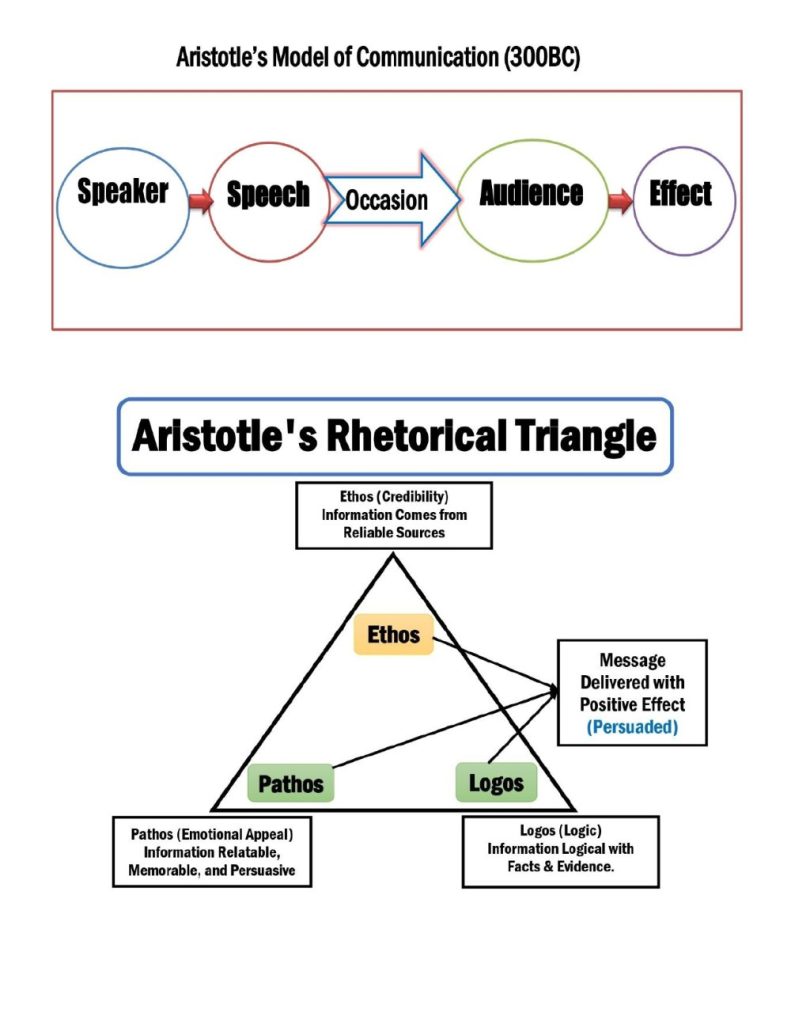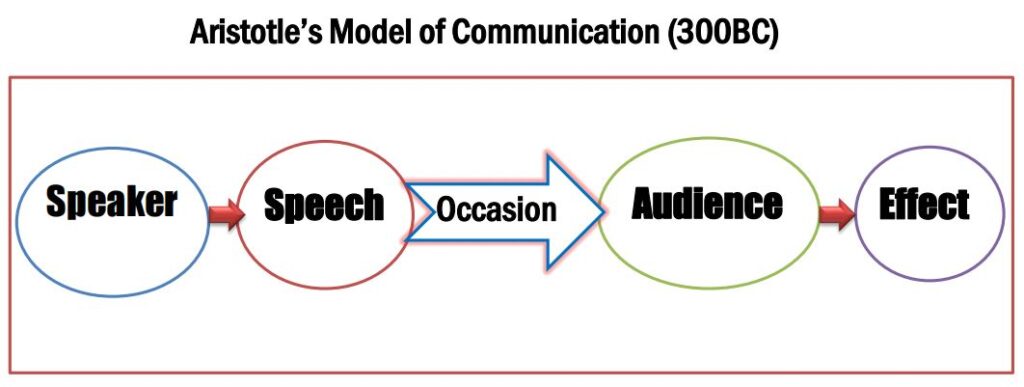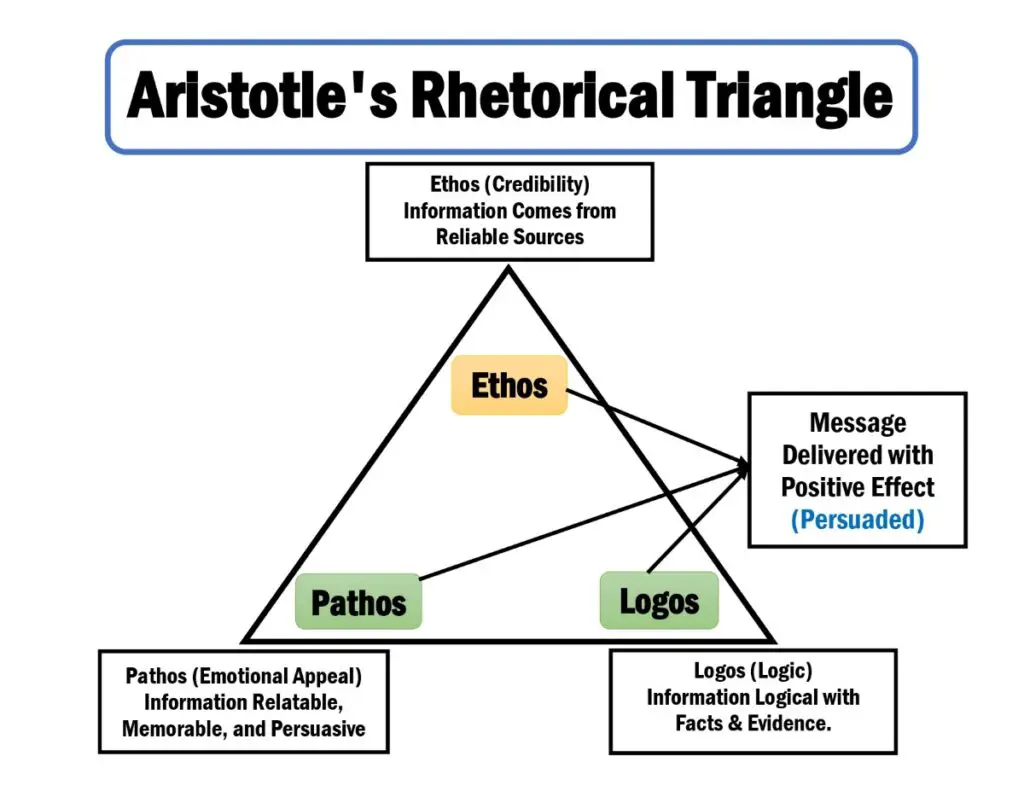Aristotle’s Model of Communication: Example Situation, Elements, and Explanation. Advantages and Disadvantages of Aristotle’s Model of Communication.
List of Contents
Aristotle’s Model of Communication
Aristotle’s communication model refers to the linear communication theory focusing on five elements: speaker, speech, occasion, audience, and effect. The Greek great scientist Aristotle introduced this most famous communication model in 300 B.C., which mainly focuses on the speech or the message. Hence, it is known as Aristotle’s communication model or Aristotelian model. The Aristotelian model is one of the most recognized communication models globally, emphasizing the speaker’s role in making a powerful speech. The Aristotle model focuses on public speaking, including how the speaker delivers a message to the audience. As this model was proposed before 300 B.C., it is regarded as the first communication model. Aristotle was a well-known Greek scientist and philosopher born in 384 BC in Stagira on the northern frontier of Classical Greece.
Aristotle’s Communication Model and Rhetorical Triangle

The three types of communication models are linear, interactive, and transactional. Aristotle’s communication theory is the initial linear model, followed by Shannon and Weaver’s and Lasswell’s communication models.
The author of this content completed a postgraduate degree in communication. He explains this model, including elements, examples, and advantages and disadvantages.
Aristotle’s Linear Model of Communication
Aristotle’s communication model describes a one-way, linear communication process. The linear communication model excludes feedback, whereas the transactional (two-way) model includes feedback. Aristotle’s communication model lacks feedback; hence, it is known as the linear model of communication.
Five Elements of Aristotle’s Communication Model
Aristotle’s communication model is designed to explain how to deliver a persuasive speech. The five components of Aristotle’s communication model are:
- Speaker
- Speech
- Occasion
- Audience
- Effect

1. Speaker in Aristotle’s Model
The speaker refers to the person who delivers the speech. It is the primary element of the communication process that initiates the conversation. Communication cannot be designed without a speaker. So, it is crucial across all types of verbal and nonverbal communication.
2. Speech in Aristotle’s Model
Speech is the message a speaker wants to convey to an audience. The speaker delivers the speech to accomplish the goal. For example, a political leader produces persuasive speeches to motivate supporters.
3. Occasion in Aristotle’s Model
Occasion refers to the context in communication that denotes the environment and explains why the conversation occurs. The speech pattern can be distinguished based on the occasion. For example, a political leader delivers speeches tailored to the situation, including during political campaigns and social and personal events.
4. Audience in Aristotle’s Model
The audience is the receiver of the speech. The speaker gives a speech to the audience. So, audiences are known as listeners. For example, supporters are the audience in the political campaign. The audience plays a passive role, impacted by the speech. There are two types of audiences: active and passive. This limits communication to a one-way flow, from speaker to receiver.
5. Effect in Aristotle’s Model
The effect is positive and negative, and the consequences of the speech are. It measures whether the audience is persuaded. For example, a marketing manager provides a promotional speech to sell a product. Here, the effect refers to customers’ buying attitudes. The effect is positive if customers purchase the products. In the political context, the communication effect is positive if followers and voters are persuaded.
Example of Aristotle’s Model of Communication
1. Delivering Speech through Radio
For example, the NBC radio station(Context) broadcast American 32nd President Franklin D. Roosevelt’s (Speaker) speech through fireside chats. The president explained (Speech) the new policies directly to the citizens(Audience). Franklin D. Roosevelt was an effective communicator, and his speech created a strong relationship (Effect) between the government and the general public. This situation is the best example of Aristotle’s model.
2. Advertisement on Television
A salesman (Speaker) advertises on Television (Context) to persuade customers (Audience) to buy a laptop at the best price. He delivers a promotional message (Speech) to convince the customers. Finally, the salesman manages to sell some laptops (Effect) through a TV advertisement. In this context, the audience listens to the speakers without providing feedback.
3. Political Speech Physically
Barack Obama (Speaker) delivers a speech to supporters (Audiences) to persuade them to vote for the Democratic Party in the general election (Context) of the United States of America. For example, many voters decide to vote (Effect) for the Democratic Party after listening to the motivational speech.
The five examples of Aristotle’s communication model are:
1. A charity organization delivering an emotional appeal through Radio to collect funds for refugees (Pathos).
2. The Dettle company advertises its shop on Television, mentioning how much bacteria it can protect against (Logos).
3. A scholar delivering a lecture on global warming using credibility (Ethos)
4. An editor wrote and published fact-based articles in newspapers to create social awareness (Logos).
5. Receiving a no-reply email from the embassy informing that the passport has been received(Ethos).
Aristotle’s Rhetorical Triangle
Aristotle described the rhetorical triangle as comprised of three elements: ethos, pathos, and logos. Any written and spoken speech is generated to persuade audiences. So, writers and speakers should include the three rhetorical components: ethos (speaker’s credibility and trustworthiness), pathos (emotional appeal), and logos (logical appeal).

Aristotle’s Rhetorical Triangle Elements
The three components of Aristotle’s Rhetorical Triangle are:
- Ethos
- Pathos
- Logos
1. Ethos (Credibility)
Ethos refers to the credibility and reliability of the information. It ensures that the information comes from reliable sources and is trustworthy. For example, people will consult an interior designer about office decoration but not a lawyer. On the other hand, they will consult with lawyers for legal advice. Ethos ensures the credibility of the person who delivers the message.
2. Pathos (Emotion)
Pathos refers to the use of emotional appeal to persuade an audience to adopt attitudes, beliefs, and behaviors. It is a crucial component of public speech for persuading audiences. Pathos taps into the audience’s emotions, values, and desires, aiming to evoke sympathy, empathy, anger, fear, or excitement. Unlike logos, which appeals to logic, and ethos, which appeals to ethics and credibility, pathos taps into the audience’s emotions, aiming to create a strong emotional connection and influence their attitudes, beliefs, and behaviors.
In communication and persuasion, pathos plays a significant role in engaging the audience deeper by eliciting emotions such as empathy, sympathy, anger, fear, or joy. By appealing to these emotions, speakers, writers, or advertisers can make their message more relatable, memorable, and persuasive. For example, in a speech advocating environmental conservation, a speaker might evoke empathy by describing the impact of pollution on wildlife, stirring the audience’s emotions and inspiring them to take action.
However, using pathos ethically and responsibly is essential, ensuring that emotional appeals are genuine.
3. Logos (Logic)
Logos refers to the use of logical reasoning, facts, evidence, and arguments to support a speaker’s position. Hence, it appeals to the audience’s intellect by presenting rational arguments, data, statistics, examples, and logical deductions.
Rhetorical Triangle Communication Example
Aristotle’s Rhetorical Triangle ensures the message is delivered with a positive effect. In communication, it also confirms that the writer or speaker persuades the audience. The scholars articulate that a good speaker applies rhetorical theory in public speech or writing.
According to Nurkhamidah, Fahira, and Ningtyas (2021), Joe Biden used all the Aristotelian rhetorical strategies in his inaugural address: pathos at 55% of the speech, followed by ethos at 37%, and logos at 8%.
What is the rhetorical triangle used for
People use Aristotle’s Rhetorical Triangle in argumentative content writing and speech delivery. In argumentative content writing, the writers include evidence and personal credibility to persuade readers. Similarly, in argumentative speech delivery, the speaker uses credibility, emotion, and logic to influence followers.
Example of Using Aristotle’s Rhetorical Triangle
For example, the United States Presidential Debates 2024 is the best example of using Aristotle’s Rhetorical Triangle. Trump and Kamala Harris joined the argumentative debate on October 1 sponsored by ABC. The political debates are the best context for applying Aristotle’s Rhetorical Triangle to persuade voters and followers.
Advantages and Disadvantages of Aristotle’s Model of Communication.
Advantages of Aristotle’s Model of Communication
Aristotle emphasized the speaker’s role in convincing the audience in his model. Therefore, it benefits anyone looking to develop their public speaking abilities. The Aristotelian model holds that the speaker must be aware of their intended audience. The speakers should prepare their speech based on the audience’s socioeconomic status, educational background, etc.
In a corporate context, managers use the three steps —Ethos, Pathos, and Logos —to enhance organizational productivity.
Aristotle’s model explains how to gain more supporters through a persuasive speech about a sports team.
Moreover, for researchers and students, Aristotle’s model serves as a motivating outcome of the systematic study of various aspects. It is also an instructive representation of the communication process that assists in system planning. It presents fresh perspectives and ideas on topics including verbal, written, and nonverbal communication.
Disadvantages of the Aristotle Communication Model
The three significant criticisms of Aristotle’s model are the Absence of Feedback, the Absence of Noise, and a focus on public speaking only.
The most crucial weakness of Aristotle’s communication model is its linear structure. It is considered to be a linear model of one-way communication. It did not include or explain the feedback essential to the interactive communication process. Due to the lack of audience feedback and openness in this communication model, the conversation is ineffective.
Additionally, its credibility and usefulness are limited because it is only helpful for public speaking.
Finally, Aristotle’s model shows no concept of noise barriers in communication. Noise is an unwanted but paramount element of the communication process.
Conclusion
The five essential elements of Aristotle’s model are speaker, speech, occasion, audience, and effect. Speakers should follow Aristotle’s model to influence their audience when speaking in public positively. It is also a crucial model to motivate audiences. Many scholars extended this theory to establish other theories in different contexts. It is the oldest model that initially provided communication concepts.
References
Nurkhamidah, N., Fahira, R. Z., & Ningtyas , A. R. (2021). Rhetorical Analysis of Joe Biden’s Inauguration Address. JL3T (Journal of Linguistics, Literature and Language Teaching), 7(2), 73-82. https://doi.org/10.32505/jl3t.v7i2.3371
Citation For This Article- APA- 7th Edition
|
Kobiruzzaman, M. M. (2025). Aristotle’s Model of Communication Example & Explanation. Newsmoor. https://newsmoor.com/aristotles-model-of-communication-example-explanation-elements
In-text citation
According to new research … (Kobiruzzaman, 2025) In research from Kobiruzzaman (2025) |
Best example for Aristotle’s model
Great
Great
I need more informatin
Good
Graat